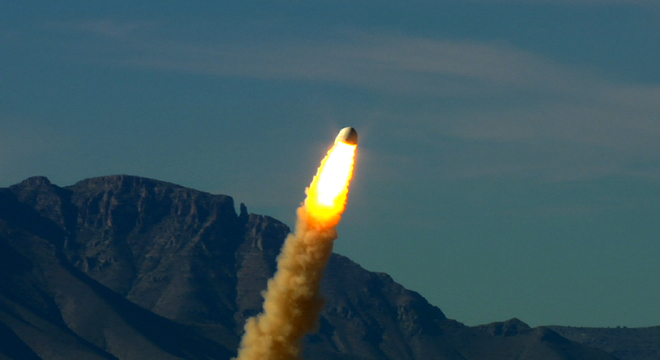Blue Origin, a commercial spacefaring startup founded and backed financially by Amazon CEO Jeff Bezos, successfully completed an unmanned test of its launch pad escape system for astronauts on October 19, NASA and Blue Origin revealed on Monday.
“The first test of our suborbital Crew Capsule is a big step on the way to safe, affordable space travel,” said Bezos in a statement posted to the Blue Origin website. “This wouldn’t have been possible without NASA’s help, and the Blue Origin team worked hard and smart to design this system, build it, and pull off this test. Lots of smiles around here today. Gradatim Ferociter!”
“Gradatim Ferociter,” is Blue Origin’s Latin motto, which means “step by step, courageously,” a description of the company’s approach toward developing reusable, safe, commercial space taxis for crew and cargo vessels for the International Space Station and other low earth orbit operations.
This test was specifically for a suborbital version of the spacecraft, however, that is, one designed to get close to space, but not all the way there. Here’s a video of the test flight originally posted by Blue Origin on Monday:
“The progress Blue Origin has made on its suborbital and orbital capabilities really is encouraging for the overall future of human spaceflight,” said NASA’s Ed Mango, manager of the agency’s Commercial Crew Program, in a statement published on the NASA’s website Monday. “It was awesome to see a spacecraft NASA played a role in developing take flight.”
The test was meant to simulate how the Blue Origin would safely abort a crewed launch to outer space if something went wrong during the initial blast-off, and involved Blue Origin launching its New Shepard Crew Capsule vessel (unmanned in this instance, but capable of holding up to seven astronauts) from its West Texas testbed, aboard a simulator launch vehicle, then activating its “pusher escape motor” to break away and perform thrust vectoring, climbing to 2,307 feet before parachuting safely to a relatively soft landing some 1,630 feet away from the launch site.
The news of the successful test is something of a redemption for Blue Origin, which in August 2011 saw one of its test launch vehicles destroyed shortly after blast off, which Bezos said at the time was the result of “a flight instability” that “triggered our range safety system to terminate thrust on the vehicle.”
An image of the New Shepard Crew Capsule during its climb away from the launch pad graces the top of this article, courtesy Blue Origin. Immediately below is an image of the Crew Capsule deploying its parachutes, also via Blue Origin:

Here’s an image of the New Shepard sitting peacefully 1,630 feet from the launch pad following the demo flight:

NASA deputy administrator Lori Garver on Monday also posted the following photo on Twitter of her visit to Blue Origin’s West Texas design facility showing the Crew Capsule awaiting further work:

Blue Origin has won a total of $25.7 million from NASA in two separate awards for development of commercial crew and cargo transportation options to outer space. NASA right now relies on the Russian Soyuz vessels to get U.S. astronauts into orbit at a reportedly pricey $60 million per seat, but is hopeful that by seeding companies like Blue Origin and SpaceX to develop less costly alternatives, it can spur a strong commercial spaceflight industry in the U.S. while at the same time focusing its resources on longer-range missions, such as to Mars or an asteroid.






